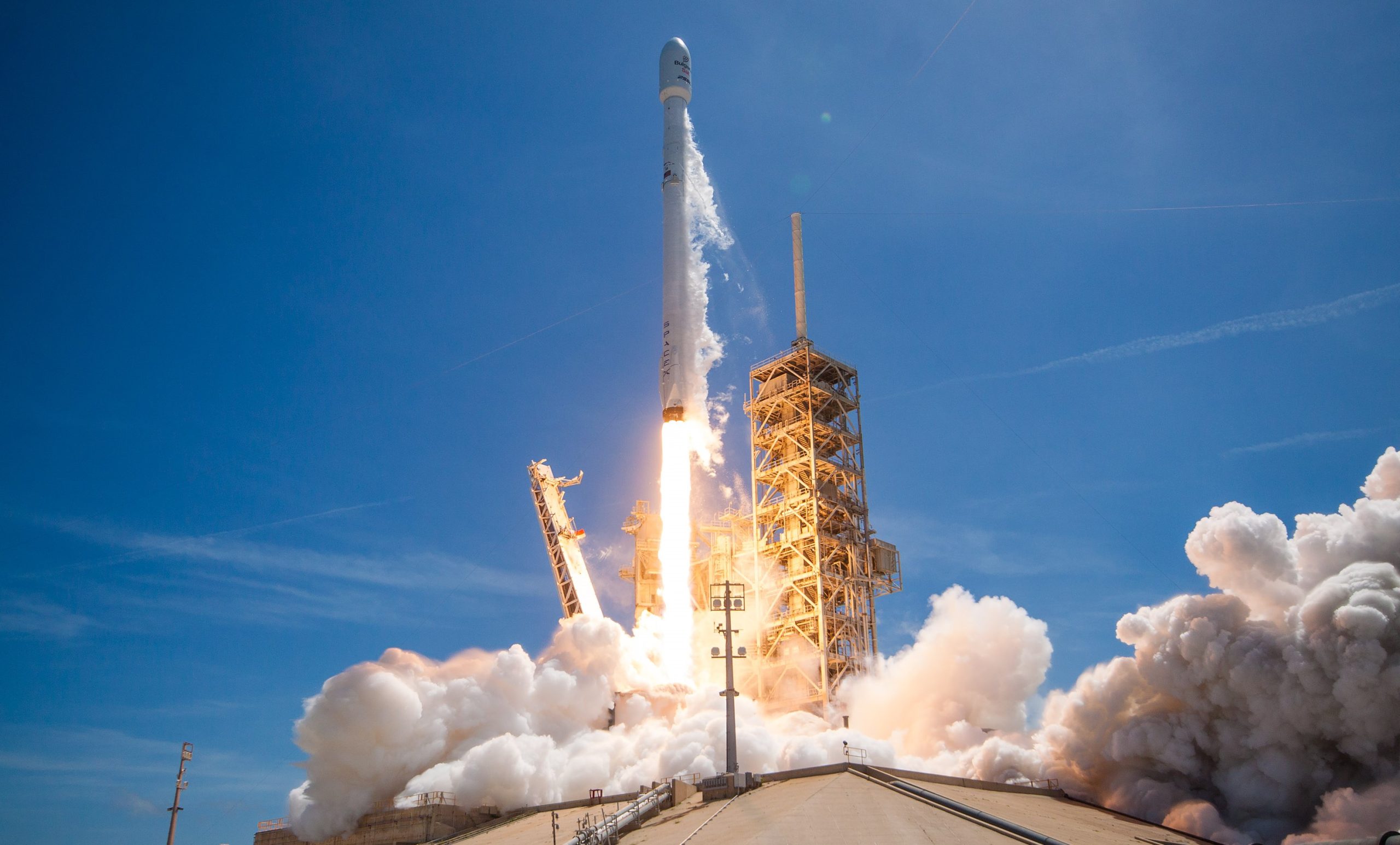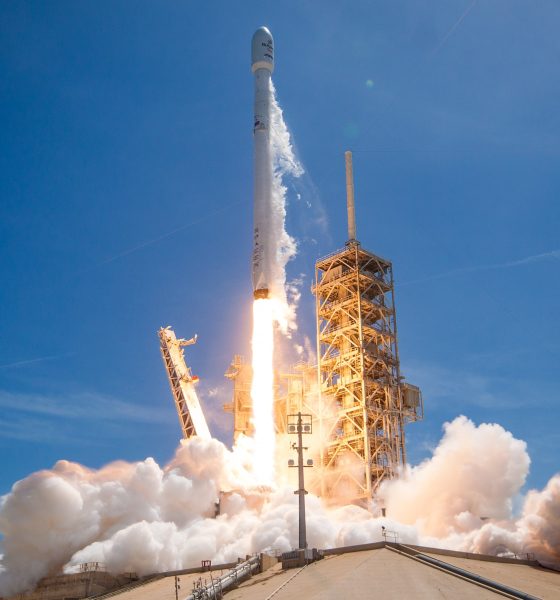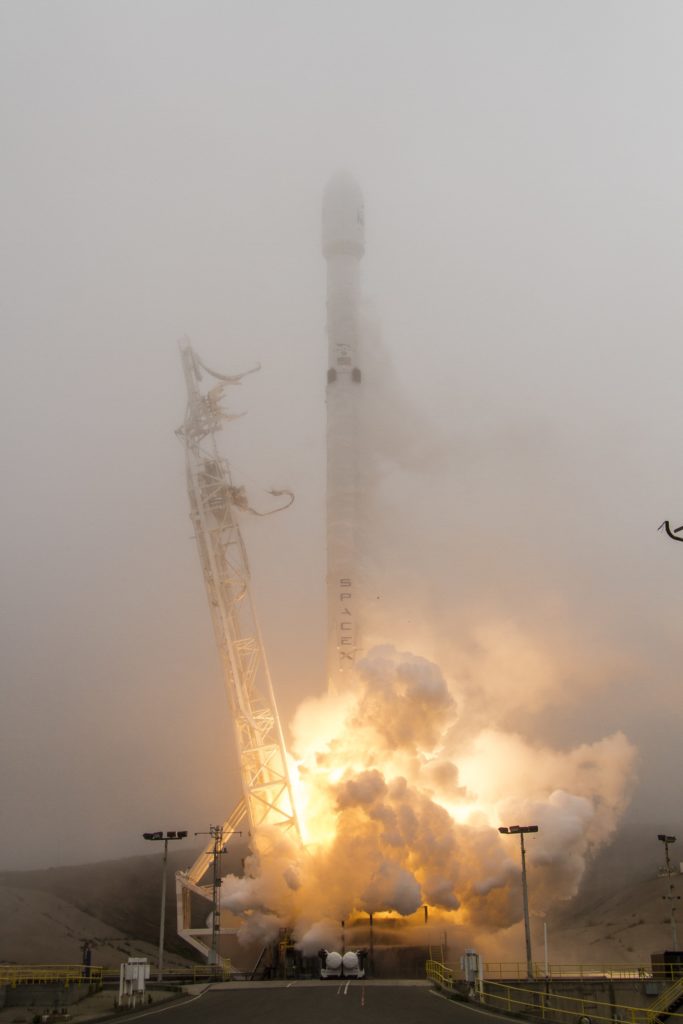

News
SpaceX on track for biweekly launch cadence in the remainder of year
Weekly rapid reuse launches expected by 2019

The foggy, atmospheric launch of Iridium-2 just yesterday. (SpaceX)
Following a weekend of extraordinary accomplishments, seeing SpaceX flawlessly execute two missions – one with a reused first stage – in just over 48 hours of each other, the company has capitalized on a uniquely successful weekend and year and offered information about their future plans.
The launch of BulgariaSat-1 and Iridium-2 on Friday and Sunday respectively marked the eight and ninth launches of 2017 for SpaceX, and officials at the company are reportedly expecting to launch approximately 24 missions this year, meaning 15 more to come over the next 6 months. Given the recent demonstration of 48 hour launch cadence and a more regular schedule of biweekly launches in the past few months, an expectation of 15 more launches for 2017 lines up perfectly with a cadence of two launches a month from LC-39A Cape Canaveral and three Iridium launches from Vandenberg, which happens to be exactly what is currently manifested.
Originally manifested for up to 27 launches this year, successfully launching 24 missions, one of which might be the inaugural flight of Falcon Heavy, would be extraordinarily hard to ignore in an industry that has compared the launch industry to manufacturing beverage containers and argued that reuse is only sustainable with more than 20 launches a year on a company’s manifest.

BulgariaSat-1 was successfully launched 48 hours before Iridium-2, and marked the second successful, commercial reuse of an orbital rocket. (SpaceX)
SpaceX is now likely to undertake 24 launches this year, but the company also revealed this weekend that it intends to achieve a regular weekly launch cadence (52 launches per year) as soon as 2019. In a recent article, I speculated that we might begin to see regular weekly launches once both LC-39A and LC-40 were active, and that appears to be nearly correct. If SpaceX is to regularly conduct weekly launches by 2019, it is bound to begin shrinking its two week cadence as soon as is safe and possible. This will likely occur once Falcon Heavy has successfully flown several times from LC-39A, thus freeing SpaceX to deem the vehicle operational and less at risk of destroying one of their two Eastern pads.
There is also a tentative understanding that SpaceX is striving to construct and activate their planned Boca Chica, Texas launch complex by 2019. The successful reactivation of LC-40 and subsequent modification of LC-39A for Falcon Heavy will leave the brunt of SpaceX’s launch complex maintenance and construction teams free to focus entirely on the Texas facility sometime late this year or early next year, meaning that Boca Chica pad activation could certainly occur as early as 2019. This would leave the company with two fully operational all-purpose launch pads dedicated to Falcon 9 launches if they choose to retain LC-39A solely for Falcon Heavy and Commercial Crew launches, allowing them to reach weekly cadences even before the launches of Falcon Heavy, Commercial Crew contracts, and Vandenberg launches are accounted for.
One crucial factor playing into SpaceX’s ability to launch 52 times in a year is of course reusability, as it is hard to imagine SpaceX more than doubling their Falcon manufacturing capabilities in under a year and a half. Likely no coincidence, SpaceX simultaneously offered information to insurance underwriters about the increasing speed of their ability to launch, recover, and reuse first stages. More specifically, a spokesman of the company stated that the reuse of BulgariaSat-1’s Falcon 9 1029 took considerably less than half as long as the inaugural reuse of the stage that launched SES-10 earlier this year, implying that refurbishment and quality assurance checks for 1029 took something like four or five months total.
With SpaceX having debuted new titanium grid fins intended to speed up reuse on the Sunday launch of Iridium-2, the company is well on its way to transferring over to Block 4 (upgraded engine performance) and possibly Block 5 of Falcon 9 later this. Block 5 is expected to introduced major changes meant to replace aspects of the current Falcon 9 that require major refurbishment after recovery. Musk detailed these changes several months ago in a Reddit AMA (Ask Me Anything), mentioning that reusable heat shielding around the engines, improved landing legs, and titanium grid fins were the main aspects of a Block 5 of Falcon 9 meant to offer rapid reuse without refurbishment. In June 22nd interview on the Space Show, Gwynne Shotwell reiterated that this “final” version of Falcon 9 is expected to be able to launch, land, and relaunch with barely more than a thorough once-over, and ought to be capable of flying a dozen missions at least.

Falcon 9’s fancy new titanium grid fins. (SpaceX/Instagram)
This final piece of the puzzle of weekly cadence fits in quite nicely. With a possible introduction date for Block 5 of late 2017 or early 2018, SpaceX will likely end production of Block 3 by the end of this year and transfer over entirely to the easily reusable Block 5. Assuming a continuing a trend of increasingly reuse-friendly customers, Hawthorne production capacity of approximately 20 Falcon 9s per year, and a plausibly significant reduction in launch costs due to more rapid and complete reuse, SpaceX could find themselves at the start of 2019 with a dozen or more launch vehicles that are each capable of conducting upwards of 10-12 highly affordable launches each.
Let there be no doubt: these are incredibly optimistic and difficult goals for the company to achieve on the timescale they have provided. However, given the number of beneficial changes likely to soon be made to both the launch vehicles and SpaceX’s manufacturing, launch, and refurbishment facilities in the next 6-12 months, those goals are realistically achievable, albeit with some likely delays. Regardless, things are beginning to get rather intense for SpaceX and for the launch industry in general.
Keep your eyes peeled for upcoming Teslarati coverage of SpaceX’s next July 4th launch and its static fire that is scheduled for as soon as this Thursday.

Elon Musk
Elon Musk and Tesla AI Director share insights after empty driver seat Robotaxi rides
The executives’ unoccupied tests hint at the rapid progress of Tesla’s unsupervised Robotaxi efforts.

Tesla CEO Elon Musk and AI Director Ashok Elluswamy celebrated Christmas Eve by sharing personal experiences with Robotaxi vehicles that had no safety monitor or occupant in the driver’s seat. Musk described the system’s “perfect driving” around Austin, while Elluswamy posted video from the back seat, calling it “an amazing experience.”
The executives’ unoccupied tests hint at the rapid progress of Tesla’s unsupervised Robotaxi efforts.
Elon and Ashok’s firsthand Robotaxi insights
Prior to Musk and the Tesla AI Director’s posts, sightings of unmanned Teslas navigating public roads were widely shared on social media. One such vehicle was spotted in Austin, Texas, which Elon Musk acknowleged by stating that “Testing is underway with no occupants in the car.”
Based on his Christmas Eve post, Musk seemed to have tested an unmanned Tesla himself. “A Tesla with no safety monitor in the car and me sitting in the passenger seat took me all around Austin on Sunday with perfect driving,” Musk wrote in his post.
Elluswamy responded with a 2-minute video showing himself in the rear of an unmanned Tesla. The video featured the vehicle’s empty front seats, as well as its smooth handling through real-world traffic. He captioned his video with the words, “It’s an amazing experience!”
Towards Unsupervised operations
During an xAI Hackathon earlier this month, Elon Musk mentioned that Tesla owed be removing Safety Monitors from its Robotaxis in Austin in just three weeks. “Unsupervised is pretty much solved at this point. So there will be Tesla Robotaxis operating in Austin with no one in them. Not even anyone in the passenger seat in about three weeks,” he said. Musk echoed similar estimates at the 2025 Annual Shareholder Meeting and the Q3 2025 earnings call.
Considering the insights that were posted Musk and Elluswamy, it does appear that Tesla is working hard towards operating its Robotaxis with no safety monitors. This is quite impressive considering that the service was launched just earlier this year.
Elon Musk
Starlink passes 9 million active customers just weeks after hitting 8 million
The milestone highlights the accelerating growth of Starlink, which has now been adding over 20,000 new users per day.

SpaceX’s Starlink satellite internet service has continued its rapid global expansion, surpassing 9 million active customers just weeks after crossing the 8 million mark.
The milestone highlights the accelerating growth of Starlink, which has now been adding over 20,000 new users per day.
9 million customers
In a post on X, SpaceX stated that Starlink now serves over 9 million active users across 155 countries, territories, and markets. The company reached 8 million customers in early November, meaning it added roughly 1 million subscribers in under seven weeks, or about 21,275 new users on average per day.
“Starlink is connecting more than 9M active customers with high-speed internet across 155 countries, territories, and many other markets,” Starlink wrote in a post on its official X account. SpaceX President Gwynne Shotwell also celebrated the milestone on X. “A huge thank you to all of our customers and congrats to the Starlink team for such an incredible product,” she wrote.
That growth rate reflects both rising demand for broadband in underserved regions and Starlink’s expanding satellite constellation, which now includes more than 9,000 low-Earth-orbit satellites designed to deliver high-speed, low-latency internet worldwide.
Starlink’s momentum
Starlink’s momentum has been building up. SpaceX reported 4.6 million Starlink customers in December 2024, followed by 7 million by August 2025, and 8 million customers in November. Independent data also suggests Starlink usage is rising sharply, with Cloudflare reporting that global web traffic from Starlink users more than doubled in 2025, as noted in an Insider report.
Starlink’s momentum is increasingly tied to SpaceX’s broader financial outlook. Elon Musk has said the satellite network is “by far” the company’s largest revenue driver, and reports suggest SpaceX may be positioning itself for an initial public offering as soon as next year, with valuations estimated as high as $1.5 trillion. Musk has also suggested in the past that Starlink could have its own IPO in the future.
News
NVIDIA Director of Robotics: Tesla FSD v14 is the first AI to pass the “Physical Turing Test”
After testing FSD v14, Fan stated that his experience with FSD felt magical at first, but it soon started to feel like a routine.

NVIDIA Director of Robotics Jim Fan has praised Tesla’s Full Self-Driving (Supervised) v14 as the first AI to pass what he described as a “Physical Turing Test.”
After testing FSD v14, Fan stated that his experience with FSD felt magical at first, but it soon started to feel like a routine. And just like smartphones today, removing it now would “actively hurt.”
Jim Fan’s hands-on FSD v14 impressions
Fan, a leading researcher in embodied AI who is currently solving Physical AI at NVIDIA and spearheading the company’s Project GR00T initiative, noted that he actually was late to the Tesla game. He was, however, one of the first to try out FSD v14.
“I was very late to own a Tesla but among the earliest to try out FSD v14. It’s perhaps the first time I experience an AI that passes the Physical Turing Test: after a long day at work, you press a button, lay back, and couldn’t tell if a neural net or a human drove you home,” Fan wrote in a post on X.
Fan added: “Despite knowing exactly how robot learning works, I still find it magical watching the steering wheel turn by itself. First it feels surreal, next it becomes routine. Then, like the smartphone, taking it away actively hurts. This is how humanity gets rewired and glued to god-like technologies.”
The Physical Turing Test
The original Turing Test was conceived by Alan Turing in 1950, and it was aimed at determining if a machine could exhibit behavior that is equivalent to or indistinguishable from a human. By focusing on text-based conversations, the original Turing Test set a high bar for natural language processing and machine learning.
This test has been passed by today’s large language models. However, the capability to converse in a humanlike manner is a completely different challenge from performing real-world problem-solving or physical interactions. Thus, Fan introduced the Physical Turing Test, which challenges AI systems to demonstrate intelligence through physical actions.
Based on Fan’s comments, Tesla has demonstrated these intelligent physical actions with FSD v14. Elon Musk agreed with the NVIDIA executive, stating in a post on X that with FSD v14, “you can sense the sentience maturing.” Musk also praised Tesla AI, calling it the best “real-world AI” today.








